Mom’s Choice Awards is excited to announce another post in our interview series where we chat with the inventors, designers, publishers, and others behind some of our favorite family-friendly products.
Mom’s Choice Awards friends welcome to another interview with some amazing honorees! Today we’ll be talking to the creators/developers of the Apple Design Award-winning Pok Pok | Montessori Preschool App. This innovatively designed app—a stimulating digital playground that parents don’t have to mute in a restaurant—redefines the way kids ages 2-7 learn and play on devices. All Pok Pok toys are designed to spark creativity, problem-solving, imagination, and learning through open-ended play.
MCA: We’d love to know more about you both, so please tell us about yourselves. Esther, why don’t you go first?
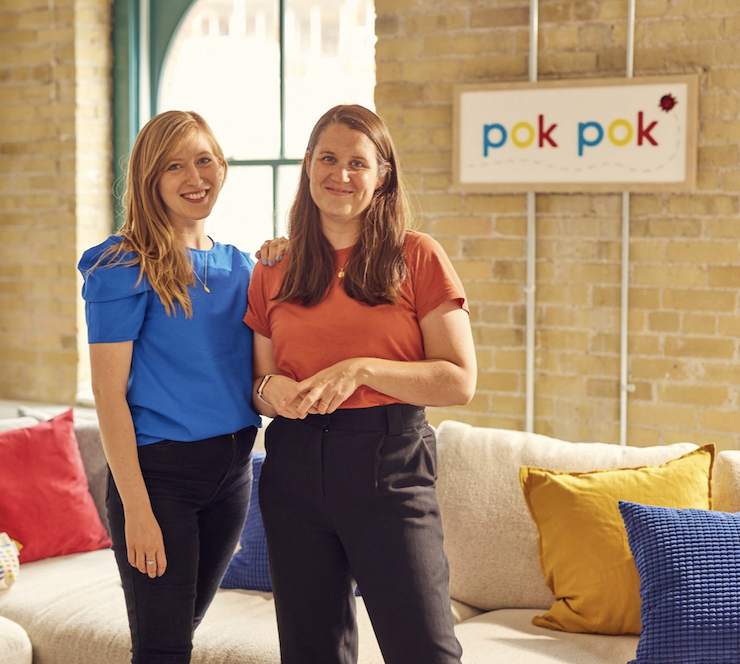
Pok Pok Co-Founders Melissa Cash(R) & Esther Huybreghts(L)
I’m Esther Huybreghts, and am one of the co-founders of Pok Pok. My husband, Mathijs Demaeght, and I are the original creators. I have a Master’s degree in Animation and Arts. We’re parents of two wonderfully spirited, funny, smart boys called James (7) and Jack (5). We live in Belgium right on the border with France in a small homestead farmhouse. Aside from drawing, I really enjoy spending long hours in my kitchen whipping up lasagnas, french fries, or hearty stews, or starting up new hobby projects that I will revisit every few months, like embroidery or writing a children’s book (which I will never finish!).
MCA: And Melissa, what’s your story?
I’m the co-founder and CEO at Pok Pok and a mom to 15- month-old Oliver. I’ve been connected to the children’s industry since I started working at an educational toy store in the suburbs of Toronto at 13 years old. I didn’t know it at the time, but it would be my first foray into an industry I would come back to time and time again. After university, I spent years working in marketing and public relations for a few start-ups, but my favorite job prior to co-founding Pok Pok was designing products for babies and toddlers at The Walt Disney Company. I’m based in Toronto and live by the Beach with my husband and son. When I’m not working you’ll find me hanging out at the beach, doing yoga, making ice cream or DIYing something around my house.
MCA: Esther, please tell us about the creation of your company and what needs you were trying to fill when you created Pok Pok?
The Pok Pok app was never meant to be anything more than a hobby project. It all started when I had just given birth to Jack, our youngest son. He had a bit of a rough start and cried a lot, so he needed a lot of tending to. My husband and I started looking for ways to keep our toddler occupied safely in those moments when we both needed to be hands-on with the baby.
We started looking for an app that would look and feel nice, wouldn’t annoy us with its loud sounds, and wouldn’t need our constant help (that would defeat the purpose!) — but we couldn’t find anything that fit our criteria. Either those apps were very gamified and addictive, or very pedagogical. Our toddler was nowhere near learning how to read and write. Aside from that, all of these apps are in English, and we’re Dutch speakers; James couldn’t understand any of them.
We were at a loss. At the same time, I felt myself slipping away yet again in the throes of motherhood. I had felt like that once before after I had given birth to my oldest son. Motherhood felt so all-encompassing, that I started to miss the person I was before I became a mom. It was a struggle! This time around, I knew the answer lay in finding my creativity again and finding that balance between being a mom and being myself.
All of these little woes led us to the point where my husband and I decided to start working on a little hobby project: an app for our kids. We would make a digital look-and-search book because James really liked pointing and finding things. Every little item could be tapped and would come to life, moving for a few seconds. The sounds would be soft and gentle and not annoying. And, maybe most importantly, it would give me a chance to work from my couch, on my iPad, making little drawings and animations—a hobby that would fit in perfectly with the stay-at-home mom life I had at the time. Little by little, the first illustrations, animations, and sounds came to life in our very first, rough prototype.
MCA: Melissa, at what point did you become involved?
In February 2018, Esther and Mathijs showed me the first illustrations they were working on for their digital look-and-search book. I’d never seen such a fresh, different art style for kids and was immediately pulled in. That was the beginning of months of conversations around the relationship kids form with technology, how it impacts their development, and how our education systems haven’t really changed in the last hundred-plus years. We all saw the need for a new, refreshing take on how kids learn and interact with media, and made the jump to start a company to do this. We want to help raise the next generation of creative thinkers through digital play.
MCA: Tell us about the research that went behind the product’s unique features, and describe these features. Esther, why don’t you start?
There are many things that make Pok Pok unique from other kids’ apps. My husband and I don’t come from a game design background, and I think this was key in how we set up the initial structure: We didn’t want any language or text (since our audience can’t read anyway) and we didn’t want any complicated menus or user interface where kids would get stuck. We didn’t want levels to beat or points to score either—that’s what usually makes screen time so addictive. Our end goal was to make the digital screen feel as close as possible to a real-life, physical playroom … as easy as walking into a room, picking up a toy from a shelf, and playing with it. The Lego set, the stack of blocks, the doll, and the cars will not tell a child if they’re playing with it the “wrong” way — they inspire different kinds of play based on what the kid wants to do that day. That same kind of child-led play is foundational to Pok Pok.
Some of our toys are inspired by real-life toys. Take Town, for example, This toy was based on the play rug a lot of us had in our homes growing up, with a bird’s eye view of a town. We turned this play concept digital and added cars, people, animals, food — you name it! Another example is House, inspired by the dollhouses we grew up with. At the same time, we also love to experiment and push the boundaries of what digital play looks like. Musical Blobs, where kids can interact with simple shapes moving on the screen in a mesmerizing way, is a good example. We just launched a toy called World Puzzle, where kids can place square puzzle pieces and build out a whole world by themselves and watch it come alive! You can’t do this in the physical world!
MCA: Melissa, anything to add?
Yes — if a child opens up Pok Pok, they’re immediately in the Playroom: a simple white space with floating circles, or “pucks,” as we call them internally. Each puck represents a toy in Pok Pok, and tapping the puck will bring you to that toy. Inside the toy, there are no menus or rules; just play! The way back to the Playroom is tucked away in another white puck in the corner of the screen — here they can choose a new toy. This basic hierarchy makes playing with Pok Pok as simple as playing with physical toys.
MCA: Please tell us what ages Pok Pok is designed for.
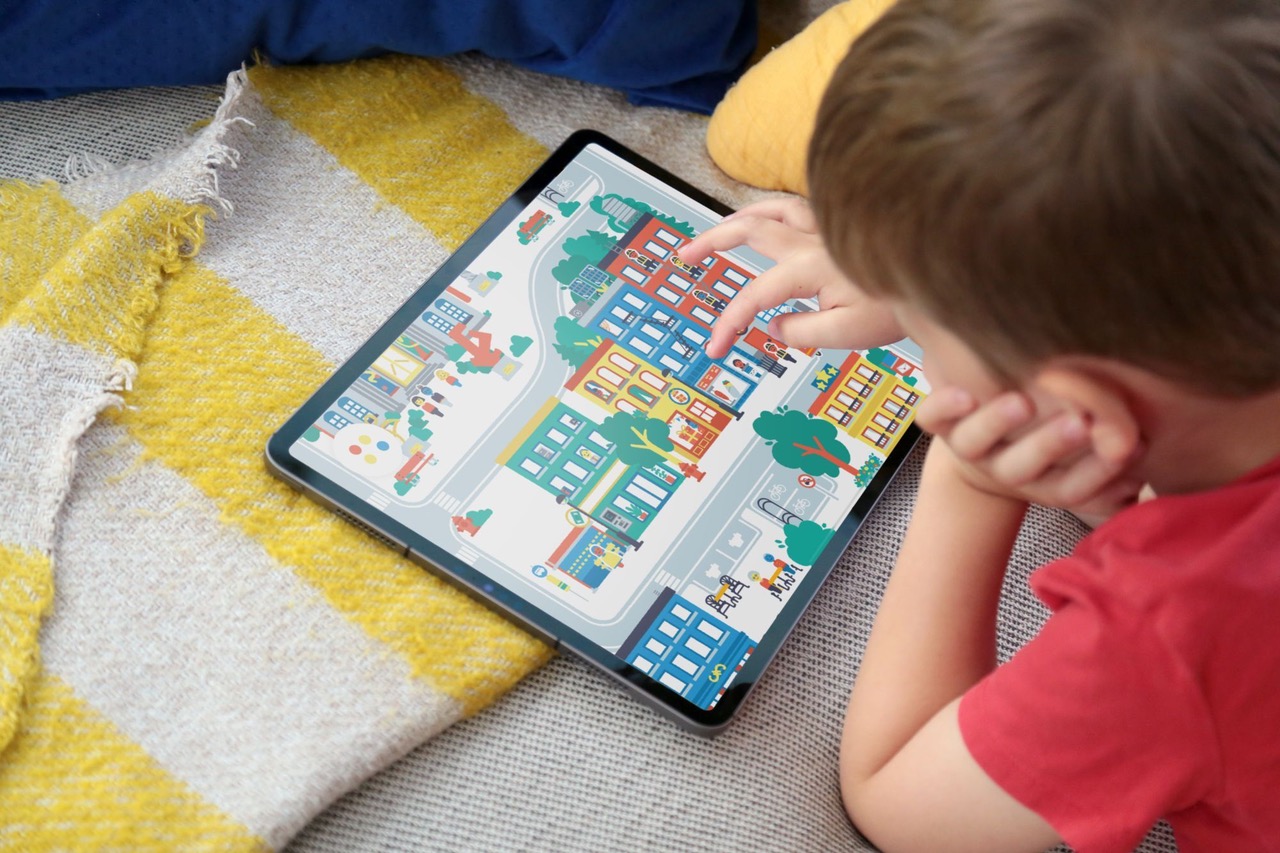 We always say Pok Pok is for ages 2-7, but we’ve noticed parents with kids as young as 1-year-old trying to find good screen time solutions for their kids, and we know Pok Pok falls in that category well. It’s easy to use even for the youngest players, and gently introduces them to technology in a way parents can feel good about. On the other end of the spectrum, we’ve heard a lot of feedback that older siblings up to age 9 also love playing around in Pok Pok, as well as neurodiverse teenagers. We also have a lot of parents tell us that they love to play around in Pok Pok after their kids have gone to sleep—and we can see why!
We always say Pok Pok is for ages 2-7, but we’ve noticed parents with kids as young as 1-year-old trying to find good screen time solutions for their kids, and we know Pok Pok falls in that category well. It’s easy to use even for the youngest players, and gently introduces them to technology in a way parents can feel good about. On the other end of the spectrum, we’ve heard a lot of feedback that older siblings up to age 9 also love playing around in Pok Pok, as well as neurodiverse teenagers. We also have a lot of parents tell us that they love to play around in Pok Pok after their kids have gone to sleep—and we can see why!
Ages aside, all toys in the Playroom have been designed with a very specific design rule in mind: Pok Pok needs to work for all ages. This means that we offer the same play experience to all of our players. We don’t cater to the kids’ age: who are we to say what a 3-year-old should be able to do? Every kid can find their fun in any toy they pick; it’s their skill level that changes the game. We love to compare it to a pile of wooden blocks: A 2-year-old will try to stack a tower together, just to topple it over, whereas a 5-year-old will take those same wooden blocks and make intricate architectural designs. The wooden blocks have grown with the child, and so does Pok Pok.
MCA: You say that it’s the most unique kid’s app on the market — Esther, please explain how and why that’s so.
I would say we’re doing almost everything differently from everyone else. We hand-draw all of our animations and illustrations; think back on the old Disney movies we grew up with. Every animation you see consists of a series of hand-drawn illustrations, playing at a speed of 24 drawings per second, which is slower than most other apps, YouTube shows, etc. All of our sounds are recorded by our in-house sound designer by hand to match the animation. They go through a careful iteration process to make sure they’re gentle, sensory-friendly, and not annoying or overstimulating. Pok Pok also has no instructions or guidelines telling kids what to do — instead, kids get to approach every single toy with a sense of freedom and curiosity.
What do they want to do today? In a world where every minute of their life seems dictated by naps, food, school, and parents; it’s refreshing for them to get some time to themselves and fill it in with what they want to do. Not many other apps approach play like this.
MCA: Those are important distinctions. Melissa, is there anything you’d like to say about this topic?
With Pok Pok, we offer a unique take on learning through play. When kids can play in a non-punitive, safe environment—where making a mistake will not “cost them points,” or make them start over or fail the game—they start to feel more confident in themselves and learn to trust their gut. When you can experiment with different solutions in a safe way, it builds resilience to make a mistake, shrug it off and try again.
All of these details, including the ones Esther mentioned, work together to make sure that Pok Pok is not addictive. This is probably our biggest differentiator—most kids’ apps are designed to keep kids using them as much as possible through addictive game mechanics, flashy sounds, and quick animations. We take the opposite approach because we know that when kids enjoy something, they’ll want to come back to it naturally—we don’t need to trick them. Pok Pok is designed not to be addictive. This helps reduce the chance of a meltdown when screen time is over, too.
MCA: Esther, please tell us about the importance of Pok Pok.
Technology is ever-present in our daily lives. We understand parents’ concerns when it comes to their kids and technology; we even share these concerns when it comes to our own kids. This is the exact reason we came up with Pok Pok in the first place! We want to offer children a chance to grow healthy screen time habits starting from a young age and to set the bar high for when they grow out of Pok Pok and start interacting with other media. After all, technology will be even more present in their future; banning them from any technology until they’re 18 will not help them form healthy habits.
MCA: Why have you chosen to represent all people, races, abilities, and genders in the app?
Melissa: We take pride in our inclusivity, making sure we represent all sizes, genders, family constructs, abilities, and skin tones as well as we can (although it’s an ongoing process!), highlighting the diversity of the world we live in. We strongly live by the fact that kids need mirrors and windows into the world—mirrors, to see themselves and their families represented in the media they consume, and windows to broaden their horizons about the world they live in. Of course, this doesn’t go without backlash; we get hateful feedback for our LGBTQIA+ content all the time. It doesn’t stop us though. We want kids to feel safe in Pok Pok. Our users are children who are already forming their biases and assumptions about the world, and we have a chance to make the world a more inclusive, safe space by showing them that everyone is equally valued and welcome in Pok Pok.
MCA: Admirable goals—and beautifully implemented. You mentioned earlier that your products are designed to be non-addictive—could you expand on that thought?
Esther: When is something addictive to our brains? It’s when the next goal, the next dopamine hit is just a swipe away. For our kids, it’s no different. Most apps are designed to get your kids addicted, whether that’s a game app where there’s another level to beat or an educational app where there’s another equation to solve and another point to score. Motivation to keep going is extrinsic. Pok Pok offers none of that. Instead, we’re counting on kids’ intrinsic motivation and curiosity to explore and play. And the reward? That’s the play and the joy itself. We receive lots of feedback from parents that kids have no trouble putting the iPad away when screen time is over and we’re very proud of that!
MCA: What other feedback have you received about the app?
Melissa: It’s been mostly overwhelmingly positive. Kids and parents are loving Pok Pok. Kids are having fun exploring the app and all it has to offer, getting inspired to bring their stories into the app, and, when screen time is over, diving right back into physical play. Parents are glad they have found a digital tool that they feel good and confident about that has eliminated their screen guilt. We also get a lot of wonderful feedback from the neurodivergent community who especially enjoy the app’s sensory-friendly, open-ended approach to play. The only negative feedback comes from people who insist our representation of the LGBTQIA+ community has no place in kids’ media.
MCA: Looking at some of your offerings, it looks as though the elements of inspiration and fun have a large part in developing them. So, Esther, what’s the most rewarding part of the business to you?
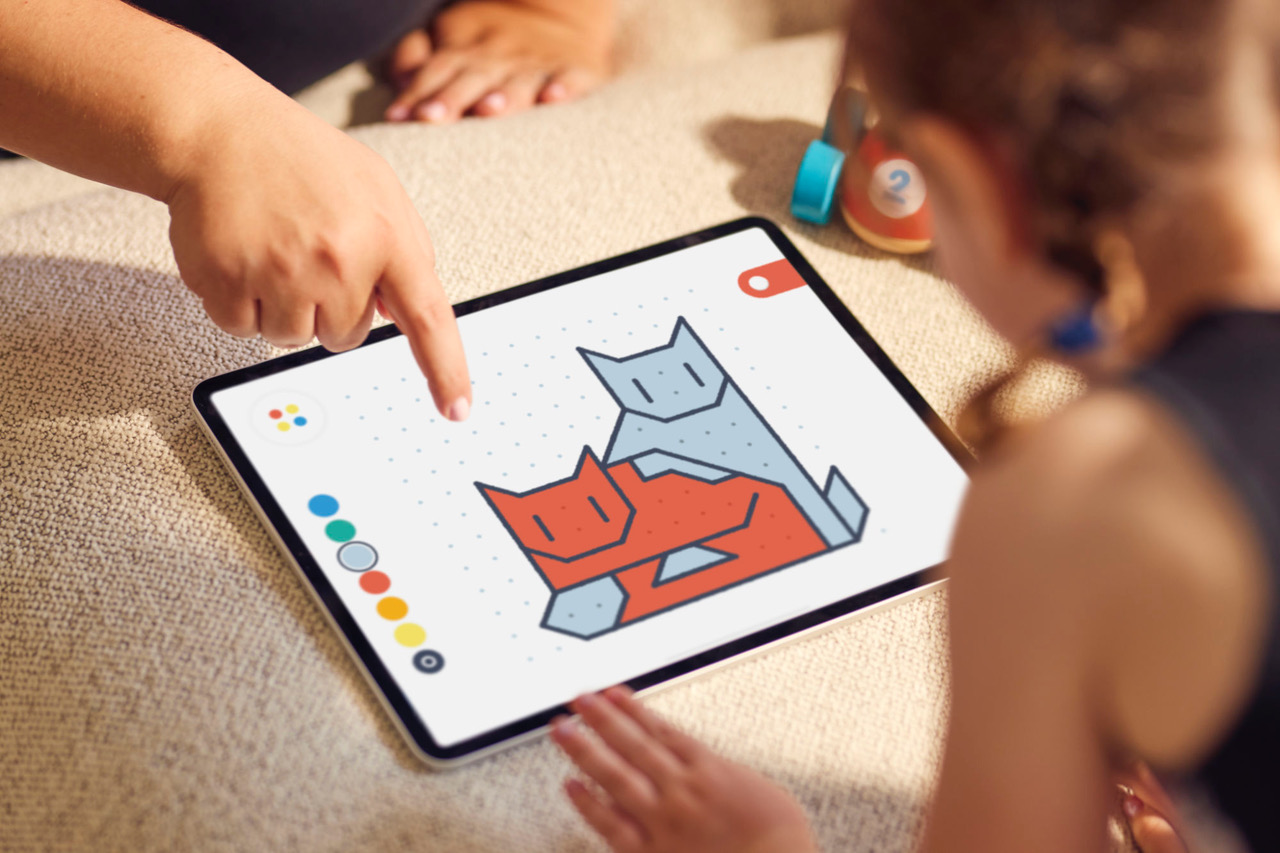 For me personally, it’s that I get to continue being a kid at heart. I always absolutely loved playing when I was a kid, and I continued to play with toys well into my teens. (And when I realized one day I couldn’t get into “the zone” anymore, I had a full identity crisis!). Working on Pok Pok lets me be a toy inventor, truly a dream come true. I love pushing the boundaries on what play in a digital space can be! And I know Melissa has some thoughts on this topic …
For me personally, it’s that I get to continue being a kid at heart. I always absolutely loved playing when I was a kid, and I continued to play with toys well into my teens. (And when I realized one day I couldn’t get into “the zone” anymore, I had a full identity crisis!). Working on Pok Pok lets me be a toy inventor, truly a dream come true. I love pushing the boundaries on what play in a digital space can be! And I know Melissa has some thoughts on this topic …
Thanks, Esther, I do. What motivates me and gets me out of bed in the morning are our users. Every piece of feedback we get from parents and their kids reminds me of the impact we have, and it’s incredibly rewarding to know we’re making a positive impact on people’s lives. When you start a company you define your mission, but knowing that we’re actually achieving it is the most beautiful feeling. I’m really proud of our whole team and what we’re doing. Plus, it helps that the videos, photos, and messages we get are usually 10/10 adorable! They make me smile every day.
MCA: That’s a pretty significant motivation! Tell us, Melissa, what is the Montessori connection?
Montessori has become a buzzword lately, but we feel strongly that we have a lot of overlap between Pok Pok and the Montessori principles. We offer a hands-on learning experience in a prepared environment where, through play, kids can learn valuable life skills like resilience, self-confidence, out-of-the-box thinking, patience, and so on. Educating the whole child is an important part of Montessori principles, and while Pok Pok strives to cover as many of those as we can, we can’t do it alone. We strive to support children’s intellectual and emotional development by touching on practical life, cultural and sensory experiences through our activities. We can’t capture an entire Montessori curriculum without physical and social components, but Pok Pok is designed to fit in seamlessly with other Montessori-style practices.
MCA: Sounds like an excellent association. So what is next for you and your products?
We’d love to expand our products to Android, as we know we have a lot of eager parents waiting to introduce it to their kids! It’s definitely on the roadmap but we don’t have a launch date for that just yet, but we will soon! We’re also interested in exploring more children’s apps at some point, but for now, we’re really focused on this one.
Esther—do you have anything to add?
We want to continue expanding the Playroom in this app, adding more exciting new toys and updates to help kids discover new kinds of play or fall in love with old favorites all over again. We have so many ideas and can’t wait to launch them.
MCA: You’re off to an amazing start—thanks so much for speaking with us today. We wish you both the very best with your innovative app that helps kids learn through play!
You can learn more about Esther Huybreghts, Melissa Cash, and their award-winning app, Pok Pok | Montessori Preschool App, by visiting their MCA Shop pages.

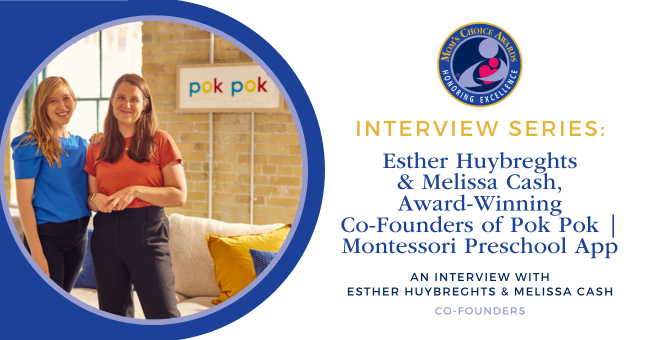
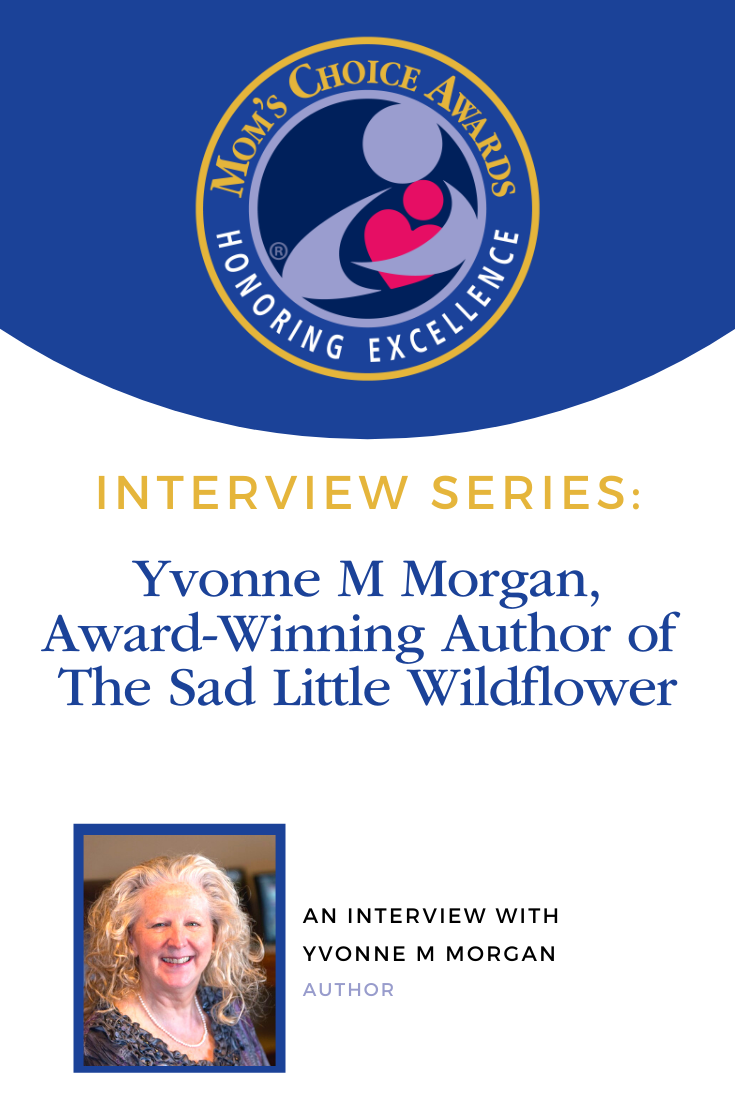

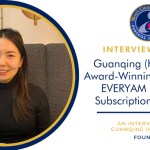


One Comment on “Interview with Mom’s Choice Award-Winners Esther Huybreghts & Melissa Cash”
This was a most interesting article.